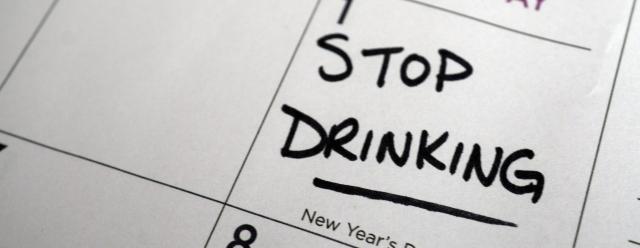Alcohol-free “Dry January” can improve sleep, blood pressure
Why It Matters:
- Taking a break from alcohol can help you decide whether your drinking habits are safe or dangerous.
- Participating in an alcohol-free “Dry January” can improve sleep and blood pressure.1
- High blood pressure, atrial fibrillation, and liver disease are among the health risks of excessive alcohol use.2,3
- Some people binge drink during the holidays, so abstinence in January provides a respite after that over-indulgence.
Giving up alcohol in January has become a popular trend the past few years. But does losing the booze for a month really improve your health? The short answer is “yes.”
“Participating in ‘Dry January,’ a New Year’s resolution to stop drinking for a month, can be a worthwhile endeavor,” explained Dr. James O’Keefe, M.D., a cardiologist and author of scientific studies on alcohol and cardiovascular health.
“I think it’s good as a reset. Take a month off, don’t drink anything. Many people say they feel healthier when they’re not drinking than when they’re drinking,” he said.
“An alcohol-free month can improve sleep and reduce blood pressure almost immediately,” said O’Keefe, medical director of the CardioWellness Center at St. Luke’s Mid America Heart Institute and a professor of medicine at the University of Missouri-Kansas City.
If consuming alcohol, moderation is key
If you don’t drink already, don’t start. If you do drink, talk with your health care provider about the benefits and risks of consuming alcohol in moderation.2 There’s a difference between drinking a glass of wine or a cocktail around the dinner hour and heavy drinking. But it’s a slippery slope between the two that some people find difficult to navigate.
Consuming alcohol “is just a very, very sharp double-edged sword,” O’Keefe said. “Dry January is a great way to test whether you are using alcohol the right way.”
We’ve all seen the headlines about studies associating light or moderate drinking with health benefits and reduced mortality. But there’s more to the story. No research has proved a cause-and-effect link between drinking alcohol and better heart health. The best-known positive health effect of alcohol is a small increase in HDL, or good cholesterol. But regular physical activity is a more effective way to raise HDL cholesterol.2
“Most people don’t drink for health benefits,” O’Keefe noted. They do it to reduce stress or generate positive feelings. Drinking alcohol may seem like a convenient way to cope with stress, but there are many other healthier strategies.
Staying physically active, eating healthy foods, getting enough sleep, meditation and other relaxation techniques, and maintaining a positive attitude are some good ways to manage stress.2
Excessive alcohol use poses health dangers
Chronic excessive alcohol use can cause liver disease, depression, obesity, and accidents.2 It can also lead to cardiomyopathy, a condition causing the heart to lose its ability to pump blood effectively.4
Evidence also indicates excessive alcohol use increases the risk of high blood pressure, stroke, cancer, heart failure, aortic aneurysm, and atrial fibrillation. Alcohol abuse is the third leading cause of premature death in the U.S. behind obesity and smoking.3
Some people who don’t normally drink may imbibe during the holiday season and even engage in binge drinking, which means having four to five drinks or more in one sitting, generally within about two hours.5
“Atrial fibrillation — an irregular and often very rapid heart rhythm that can lead to a stroke6 — has been associated with binge drinking and was often called ‘holiday heart syndrome’ when doctors diagnosed it in hospital emergency rooms during times of common celebrations, such as the holidays,” O’Keefe explained.
How much alcohol is too much?
According to the Centers for Disease Control and Prevention, in 2018, two-thirds of American adults consumed alcohol. Of those, 5.1% engage in heavy drinking.7
The American Heart Association recommends that alcoholic beverages be consumed only in moderation, if at all. Moderate alcohol consumption means an average of one to two drinks per day for men and one drink per day for women.2
When consuming alcohol, pay close attention to the amount in each serving. A standard drink is a 12-ounce regular beer, five ounces of wine, or 1.5 ounces of 80-proof spirits, such as bourbon, vodka, or gin.2
“Drinking alcohol is sort of a privilege,” O’Keefe said. If you enjoy sipping a glass of wine, a beer or a cocktail now and then, keep moderation in mind to protect your health. “By far, the most important thing is keeping to those limits.”
Adding up the cost of alcohol
Another reason to consider participating in “Dry January” – and possibly reducing or quitting alcohol all year long – is the cost. Drinking too much alcohol can hurt your pocketbook.
Do the math with an alcohol calculator to figure out your weekly, monthly, or annual tab. Depending on the brand of alcohol and whether you’re buying wine or beer for home or springing for a cocktail at a bar or restaurant, two drinks a day could range in cost from $240 to $900 per month and from $2,900 to $11,000 a year.
The cost of alcohol may also show itself when you step on the scale. Alcohol contains calories and few nutrients, so if you are trying to lose weight consider reducing or eliminating alcohol.8
Embarking on “Dry January” and the year ahead
As many as 15% of Americans who participated in a survey reported they planned to take part in the 2021 “Dry January,” up slightly from previous years, surveys from Morning Consult, YouGov, and Attest all found. Participants cited reasons such as drinking too much amid the COVID-19 pandemic or wanting a healthier lifestyle.9
If you try to give up alcohol but have trouble doing it, that may be a warning sign. It’s a good idea to talk to your health care provider for advice and support on quitting.
Once February rolls around, consider staying alcohol free. But if you decide to drink, be very mindful of portions and limit the number of beverages you have each day. Your happy hours can remain safe and enjoyable if you limit your use of alcohol.
Things to Consider:
- Quitting drinking for the month of January can help you assess how you’re using alcohol all year long.
- Reducing or eliminating alcohol consumption not only boosts your health — it saves you money.
- If you return to drinking after “Dry January,” pay attention to drink portions and the number of alcoholic beverages you have each day.
1 “Why Do a Dry January, Alcohol Change UK, accessed December 2021
2 “Is drinking alcohol part of a healthy lifestyle,” American Heart Association, December 2019
3 “Hereʼs to Your Health: Why a Drink With Dinner Might Improve Longevity,” Mayo Clinic Proceedings, 2021
4 “Cardiomyopathy,” Johns Hopkins Medicine, 2021
5“Alcohol Questions and Answers,” Centers for Disease Control and Prevention, February 2021
6 “Atrial Fibrillation,” Mayo Clinic, October 2021
7 “Heavy Drinking Among U.S. Adults,” Centers for Disease Control and Prevention, August 2020
8 “Alcohol calorie calculator,” National Institutes of Health, accessed December 2021
9 “New Surveys Indicate Increasing Interest In Dry January,” Forbes, January 2021
Transamerica Resources, Inc. is an Aegon company and is affiliated with various companies which include, but are not limited to, insurance companies and broker dealers. Transamerica Resources, Inc. does not offer insurance products or securities. The information provided is for educational purposes only and should not be construed as insurance, securities, ERISA, tax, investment, legal, medical or financial advice or guidance. Please consult your personal independent professionals for answers to your specific questions.



